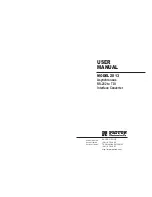
Page 11
©
2009 Magnum Energy Inc
.
Installation
2.1.5 Wiring the Inverter
This section also describes the requirements and recommendations for wiring the MS-PAE Series
Inverter/Charger. Before wiring the MS-PAE Series inverter/charger, read all instructions.
All wiring should meet all local codes and standards and be performed by qualifi ed per-
sonnel such as a licensed electrician.
The NEC (National Electric Code, ANSI/NFPA 70) for the United States and the CEC (Canadian
Electrical Code) for Canada provide the standards for safely wiring residential and commercial
installations. The NEC/CEC lists the requirement for wire sizes, overcurrent protection and instal-
lation methods and requirements.
Inverter/charger systems involve power from multiple sources (inverter, generator, utility, batter-
ies, solar arrays, etc.) which make the wiring more hazardous and challenging.
The input and output AC and DC circuits are isolated from the inverter chassis. The inverter system
grounding is the responsibility of the installer in accordance with the NEC.
WARNING
: Ensure all sources of DC power (i.e. batteries, solar, wind or hydro) and
AC power (utility power or AC generator) are de-energized (i.e. breakers opened,
fuses removed) before proceeding - to prevent accidental shock.
2.1.6 Protecting Wire - Conduit Box or Inverter Enclosure
The AC and DC wires into and out of the inverter must be protected by rigid tubing, as required by
code to comply with residential and commercial installations. This is normally done by feeding the
wires through conduit. Magnum provides a DC conduit box (ME-CB), a single inverter enclosure
(MMP Series), or a multiple inverter enclosure (MP Series) that includes the necessary AC and DC
inverter breakers that can be purchased to allow both the AC and DC conduit to be connected to
the inverter.
2.1.7 Wiring Requirements
All conductors that are at risk to physical damage must be protected by conduit, tape, or
placed in a raceway.
Always check for existing electrical, plumbing or other areas of potential damage prior to mak-
ing cuts in structural surfaces or walls.
Both AC and DC overcurrent protection must be provided as part of the installation.
The inverter requires a reliable negative and ground return path directly to the battery.
Use only copper wires with a minimum temperature rating of 90°C.
2.1.8 Wire Routing
Before connecting any wires, determine all wire routes throughout the home to and from the in-
verter. Typical routing scenarios are:
AC input wiring from the main AC panel to the inverter
AC input wiring from a generator (optional) to the inverter
DC input wiring from the batteries to the inverter
AC output wiring from the inverter to the AC sub-panel or to dedicated circuits
Battery Temperature Sensor cable from the inverter to the batteries
Remote Control cable (optional) to the inverter
Ground wiring from the inverter to an external ground
2.1.9 Torque Requirements
Torque all AC wiring connections to 16 in lbf (1.8 Nm). Torque DC cable connections from 10 to
12 ft lbf (13.6 to 16.3 Nm).
•
•
•
•
•
•
•
•
•
•
•
•
















































